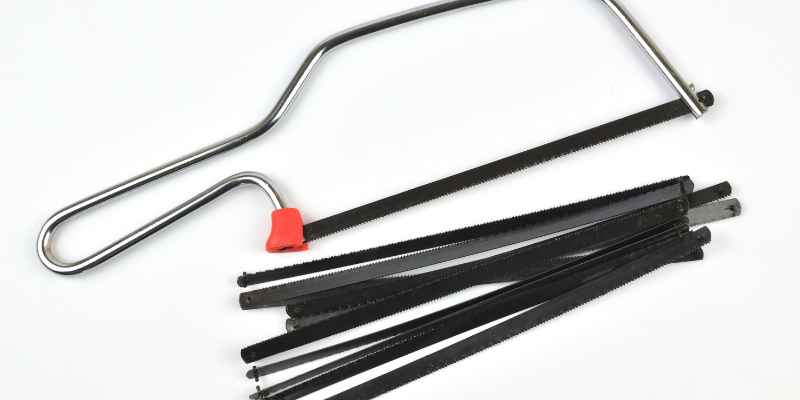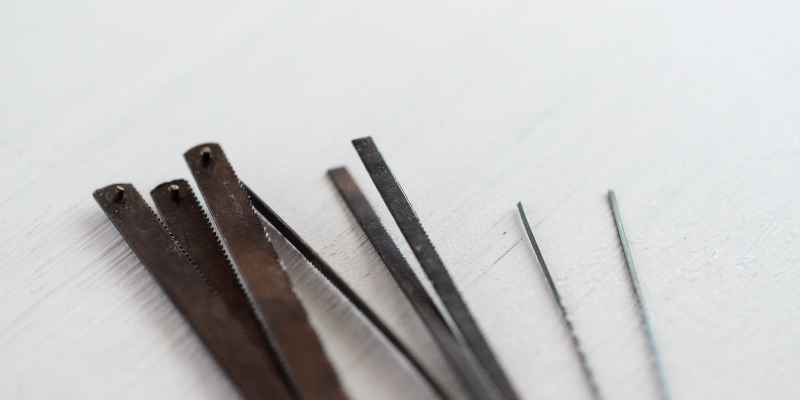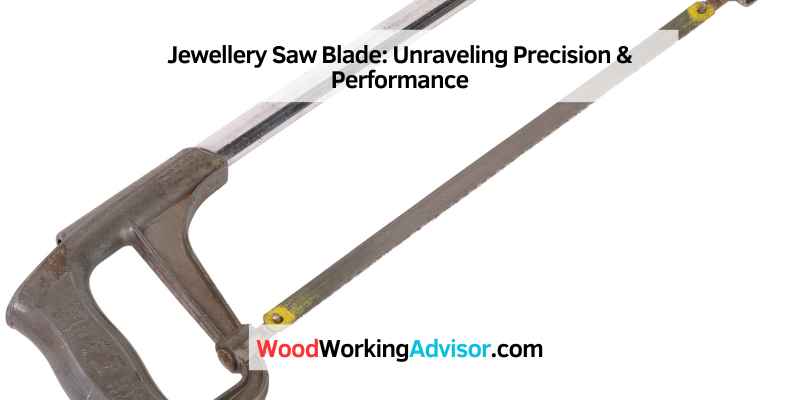A jewellery saw blade is a small, sharp tool used for cutting intricate designs in jewellery making. It is ideal for cutting through metal, such as gold, silver, or platinum, with precision and accuracy.
With its fine teeth and thin profile, it allows jewellers to create intricate shapes and patterns in their designs. Jewellery saw blades come in various sizes and materials, including high-speed steel, carbon steel, and diamond-coated blades, each suited for different types of jewellery projects.
Whether you are a professional jeweller or a hobbyist, a jewellery saw blade is an essential tool to achieve intricate and precise cuts in your jewellery designs.

The Basics Of Jewellery Saw Blades
Jewellery saw blades are an essential tool for any jewellery maker. They are thin, sharp, and flexible blades that are used to cut through various materials. In this blog post, we will explore the basics of jewellery saw blades, including the types of blades available and the materials used to make them.
There are several types of jewellery saw blades to choose from, each with its unique characteristics and uses. The choice of blade depends on the material being cut and the desired precision. Here are some commonly used types of jewellery saw blades:
- Spiral Saw Blades: These blades have teeth that are twisted in a spiral pattern. They are perfect for intricate and curved cuts in thin materials like metal sheets or wire.
- Straight Saw Blades: As the name suggests, these blades have teeth that are straight and parallel to the blade. They are ideal for cutting straight lines in thicker materials.
- Swiss Saw Blades: Swiss saw blades are known for their exceptional durability and precision. They are great for delicate and intricate cuts in materials like gold, silver, and platinum.
- Gauge Saw Blades: These blades have teeth that are spaced wider apart, making them suitable for cutting thicker materials like wood or leather.
- Diamond Saw Blades: These blades are embedded with diamond particles, making them incredibly strong and long-lasting. They are mainly used for cutting hard materials like gemstones and ceramic.
Jewellery saw blades are made from a variety of materials, each offering different advantages and suitability for specific purposes. The most commonly used materials in jewellery saw blades include:
- High-Speed Steel (HSS): HSS blades are popular due to their ability to withstand high temperatures and maintain their sharpness for longer. They are suitable for cutting metals and tougher materials.
- Carbon Steel: Carbon steel blades are cost-effective and widely used in jewellery making. They are ideal for cutting soft metals and alloys.
- Titanium-Coated Blades: Blades with a titanium coating have enhanced hardness and durability. They are excellent for cutting abrasive materials like glass and stone.
Choosing the right jewellery saw blade is crucial to ensure clean, precise cuts and a smooth working experience. Consider the type of material you are working with, the intricacy of the design, and the desired level of precision when selecting the appropriate blade for your jewellery making projects.
Factors Influencing Precision
Precision in jewellery saw blades is influenced by several factors, including blade material, teeth per inch, size, and blade tension. These factors play a crucial role in ensuring clean and accurate cuts during jewellery making processes.
When it comes to jewelry making, precision is crucial for creating intricate and detailed designs. The choice of jewelry saw blade plays a significant role in achieving the desired level of precision. Several factors impact the precision of a jewelry saw blade, including blade size and thickness, as well as the teeth per inch (TPI).
Blade Size And Thickness
The blade size and thickness are fundamental factors that greatly influence the precision of cutting jewelry materials. Thicker blades provide stability and are suitable for cutting through denser materials, while thinner blades offer more flexibility, allowing for intricate and delicate cuts.
Teeth Per Inch (tpi)
The number of teeth per inch (TPI) on a jewelry saw blade significantly impacts its precision. A higher TPI means more teeth per inch, resulting in finer and smoother cuts. Conversely, a lower TPI is ideal for rough and fast cutting, making it essential to choose the appropriate TPI based on the specific requirements of the jewelry design.
In addition to blade size, thickness, and TPI, the material of the blade and the tension in the saw frame also influence the precision of jewelry saw blades. Understanding these factors is essential for achieving the desired level of precision in jewelry-making projects.
Understanding Performance
When it comes to choosing the right jewellery saw blade, understanding its performance is essential. The performance of a saw blade is crucial in determining its effectiveness and efficiency in cutting through different materials. This article focuses on understanding the performance of jewellery saw blades, with a specific emphasis on durability and longevity as well as cutting speed and efficiency.
Durability And Longevity
Jewellery saw blades that exhibit high durability and longevity are essential for professional jewellers and hobbyists alike. These blades are designed to withstand the rigors of frequent use, ensuring consistent cutting performance over time. The material and construction of the blade play a significant role in determining its durability. Blades made from high-quality steel or other durable materials tend to last longer and maintain their sharpness through extended usage. A longer lifespan means fewer blade replacements, thereby reducing costs and maximizing efficiency.
Cutting Speed And Efficiency
The cutting speed and efficiency of jewellery saw blades are critical factors that impact overall performance. Blades that offer high cutting speed help jewellers complete their projects faster, increasing productivity and saving time. Additionally, efficient blades produce clean and precise cuts, minimizing the need for extensive finishing work. A blade’s tooth design, size, and material compatibility contribute to its cutting speed and efficiency, so choosing the right blade for specific cutting tasks is vital.
Choosing The Right Blade For The Job
Selecting the right jewellery saw blade is crucial for precision and accuracy in cutting various metals and materials. Factors to consider include the blade’s teeth per inch (TPI), thickness, and material compatibility to ensure optimal performance for your specific jewellery crafting needs.
Jewellery saw blades are a crucial tool for any jewellery maker or metalworker. Choosing the right blade for the job can make a significant difference in the results you achieve. Whether you’re working with different metal thicknesses or tackling intricate designs, selecting the appropriate blade is essential for a clean and precise cut. In this article, we’ll explore two key factors to consider when choosing a jewellery saw blade: metal thickness and type, and intricate design vs. straight cuts.
Metal Thickness And Type
When it comes to jewellery making, metal thickness and type are important considerations when choosing the right saw blade. Different metals require different blades for efficient cutting. Here’s a breakdown of the recommended blade sizes for common metal thicknesses:
| Metal Thickness | Recommended Blade Size |
|---|---|
| Up to 0.5mm | #2/0 |
| 0.5mm – 1.0mm | #2 |
| 1.0mm – 2.0mm | #1 |
| Above 2.0mm | #1/0 |
Remember to choose a blade with the right teeth per inch (TPI) to match the metal thickness. Higher TPI blades are suitable for thinner metals, while lower TPI blades are better for thicker metals.
Intricate Design Vs. Straight Cuts
Another consideration when choosing a jewellery saw blade is whether your project requires intricate designs or straight cuts. For intricate designs, finer blades with more teeth per inch (TPI) are typically used to achieve precise and detailed cuts. These blades allow for better control and maneuverability in tight curves and corners.
On the other hand, if you’re working on straight cuts or larger sections, a blade with fewer teeth per inch (TPI) is recommended. These blades remove material quickly and are more suitable for straight, long cuts.
Keep in mind that the trade-off between speed and precision is a crucial factor in choosing the right blade for your specific project.
In conclusion, selecting the right jewellery saw blade is vital for achieving clean, precise cuts in your metalworking projects. Consider the metal thickness and type, as well as the nature of your project, whether intricate or straight cuts. By choosing the appropriate blade, you’ll ensure optimal results, saving time and effort in your jewellery making journey.
Maintenance And Care Tips
Maintenance and care are crucial to ensure the longevity and effectiveness of your jewellery saw blade. Follow these handy tips to keep your blade in top condition.
Proper Blade Installation
- Ensure the blade is installed securely to avoid slippage during use.
- Check that the blade is aligned properly to prevent breakage.
- Tighten the blade according to the manufacturer’s guidelines.
Cleaning And Lubrication
- Regularly clean the blade with a soft cloth to remove debris and prevent buildup.
- Apply a small amount of lubricant to reduce friction and enhance cutting performance.
- Avoid using harsh chemicals that may damage the blade’s integrity.
Advanced Techniques For Precision Cutting
When it comes to intricate and precise jewellery cutting, advanced techniques are essential to achieve the desired results. Utilizing the right tools and mastering these techniques can elevate the quality and intricacy of jewellery designs, making them stand out in the industry.
Curved Cuts And Angled Designs
Curved cuts in jewellery making require finesse and precision. With the right saw blade, intricate curves and angles can be achieved, enhancing the overall aesthetic of the piece. Advanced techniques for curved cuts involve using the saw blade to carefully navigate through the metal, creating elegant and fluid lines that contribute to the beauty of the jewellery.
Inlay And Filigree Work
Inlay and filigree work demand meticulous attention to detail. The jewellery saw blade enables artisans to intricately cut patterns and shapes for inlay work, enhancing the visual appeal of the piece. Precision cutting with the proper techniques results in seamless inlay and intricate filigree designs that elevate the craftsmanship of the jewellery.
Troubleshooting Common Issues
Using a jewellery saw blade can be a delicate process, and it’s not uncommon to encounter some common issues along the way. Understanding how to troubleshoot these problems can help you achieve cleaner, more precise cuts and prevent unnecessary frustration. In this article, we will discuss two of the most common issues that jewellers frequently face when using a jewellery saw blade: blade breakage and snapping, and wandering or drifting cuts.
Blade Breakage And Snapping
One of the primary concerns when using a jewellery saw blade is blade breakage and snapping. This can happen due to various reasons, and it’s essential to identify and address the underlying causes to prevent this issue from recurring. Here are some common causes of blade breakage:
- Inadequate blade tension: Insufficient tension can cause the blade to deflect and eventually break. To ensure proper tension, use a tension gauge or tighten the blade just enough to get a clear, audible “ping” sound when plucked.
- Blade misalignment: If the blade is not properly aligned in the saw frame, it can result in excessive stress and breakage. Make sure the teeth of the blade are facing forward and that it is centered in the frame.
- Using the wrong blade size: Choosing the appropriate blade size for your specific cutting needs is crucial. Using a blade that is too thin or too thick for the material can lead to breakage. Refer to the manufacturer’s recommendations or seek guidance from experienced jewellers.
- Applying excessive pressure: Pressing too hard while cutting can strain the blade and cause it to snap. Remember to let the saw do the work and apply gentle, consistent pressure without forcing it.
- Using worn-out blades: Over time, blades can lose their sharpness and become prone to breakage. Replace worn-out blades regularly to maintain optimal performance.
Wandering Or Drifting Cuts
Another common issue that jewellers encounter is wandering or drifting cuts. These cuts deviate from the intended path and can result in misshapen or inconsistent designs. Here are some possible causes and solutions for wandering cuts:
| Cause | Solution |
|---|---|
| The blade is not perpendicular to the workpiece | Ensure that the saw frame is positioned correctly and that the blade is perpendicular to the material you are cutting. |
| Poor hand positioning | Hold the saw with a relaxed grip, keeping your hand and arm aligned with the saw frame to maintain control and stability. |
| Inadequate lubrication | Apply an appropriate lubricant to the blade to reduce friction and ensure smoother cuts. This will help prevent the blade from wandering off track. |
| Using the wrong blade type | Consider using a different blade with a finer tooth pattern if you are experiencing wandering cuts. Finer blades offer better control and precision. |
By addressing these common issues with your jewellery saw blade, you can improve your cutting technique and achieve better results in your jewellery-making projects. Remember to always practice patience and take the time to troubleshoot any problems that arise. Happy sawing!

Future Innovations And Trends
The future of jewellery saw blades is set to be revolutionized through advanced technologies and sustainable practices. Let’s explore upcoming trends in the industry.
Nano-coating Technology
Nano-coating technology is paving the way for enhanced durability and precision in jewellery saw blades, offering improved cutting performance.
Biodegradable Blade Options
Biodegradable blade options are gaining prominence, aligning with the sustainability trends in the jewellery industry, providing eco-friendly solutions.
Frequently Asked Questions Of Jewellery Saw Blade
What Are Jewellery Saw Blades Made Of?
Jewellery saw blades are typically made of high-quality steel to ensure durability and precision cutting. Some may also feature special coatings or alloys for added strength and resistance to wear.
How Do I Choose The Right Jewellery Saw Blade?
When choosing a jewellery saw blade, consider the material you’ll be cutting, as well as the intricacy of your design. Opt for finer blades for delicate work, and coarser blades for thicker materials.
What Are The Advantages Of Using A Jewellery Saw Blade?
Using a jewellery saw blade allows for precise and intricate cuts, making it ideal for creating detailed designs in metal and other materials. It offers greater control and maneuverability compared to other cutting tools.
How Often Should I Replace My Jewellery Saw Blade?
It’s recommended to replace your jewellery saw blade regularly, especially if you notice dulling or decreased cutting performance. For frequent users, a good practice is to switch out the blade after every few projects to ensure optimal results.
Conclusion
To wrap up, choosing the right jewellery saw blade is crucial for achieving precision and quality in your projects. By understanding the different types of blades available and considering factors such as material, thickness, and tooth count, you can ensure a smooth cutting experience.
Remember to prioritize durability, sharpness, and compatibility with your jeweller’s saw to optimize your jewellery-making process. Don’t compromise on the quality of your blades; invest wisely for exceptional results.


